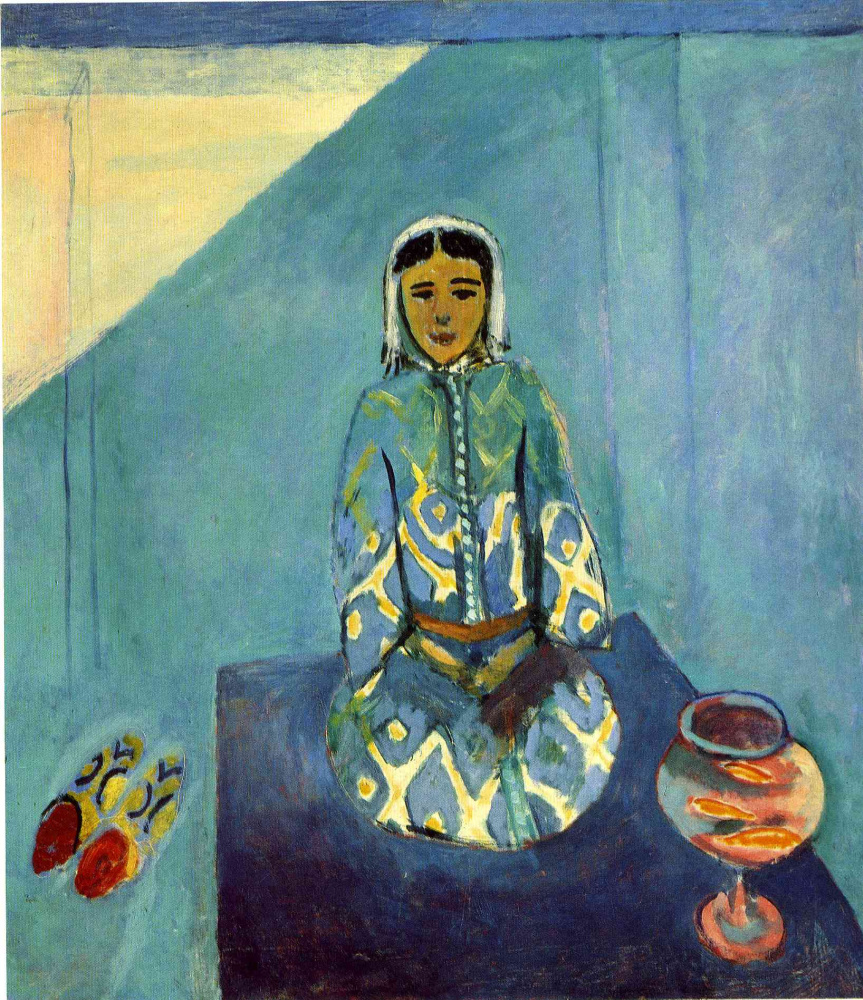log in
Enter site
Login to use Arthive functionality to the maximum
Zorah on the Terrace
Henri Matisse • Painting, 1913, 115×100 cm
Description of the artwork «Zorah on the Terrace»
At the end of January, 1912 Henri Matisse and his wife Amélie went to Morocco. In Tangier he planned to execute a number of commissions from the Russian collectors Sergei Shchukin and Ivan Morozov. The former hinted that he preferred to work with figures, but it was extremely difficult to find the sitter there. According to Muslim customs, women were prohibited not only from posing, but also from uncovering their faces (this law did not apply to prostitutes).
Only two months later, thanks to the efforts of the local French – the owners of the hotel in which the artist stayed, it was possible to find a model. At that time, Zorah was no more than twelve years old – still quite a child by European standards, but in Morocco she was considered old enough to get married or engage in prostitution. But the girl couldn't pose for a foreigner for long: "There's her brother," wrote Matisse. "I think he would have killed her if he found out that she poses."
He managed to resume the sessions with Zora during his second visit to Tangier almost six months later. She was found working in a brothel. Therefore, the girl posed for Matisse on the rooftop of the brothel, where she came in between the reception of customers. In total, the young Moroccan became the subject of three works by Matisse (1, 2).
The artist liked the national costume of the girl: this is the most detailed element in the picture Zorah on the Terrace. Whereas he paid much less attention to the hands (one of the critics mentioned that they were notable for “a stupefying absence”).
During his recent visit to Moscow, the artist was very inspired by the ancient Russian icon painting. This influenced the manner of depicting the subjects of the Moroccan period, more reminiscent of the faces of the saints. Without knowing the history of this painting, it is impossible to guess Zorah's occupation, since the girl looks very modest and chaste.
Although Matisse initially had no intention of painting a triptych, over time he decided to combine the three paintings created at that time into the Moroccan triptych. In addition to Zorah on the Terrace, it also includes paintings View from a Window and Entrance to the Kasbah. In 1913 the triptych entered the Morozov Collection, where it was kept until 1919. Now the Moroccan triptych is here.
Author: Natalia Azarenko
Only two months later, thanks to the efforts of the local French – the owners of the hotel in which the artist stayed, it was possible to find a model. At that time, Zorah was no more than twelve years old – still quite a child by European standards, but in Morocco she was considered old enough to get married or engage in prostitution. But the girl couldn't pose for a foreigner for long: "There's her brother," wrote Matisse. "I think he would have killed her if he found out that she poses."
He managed to resume the sessions with Zora during his second visit to Tangier almost six months later. She was found working in a brothel. Therefore, the girl posed for Matisse on the rooftop of the brothel, where she came in between the reception of customers. In total, the young Moroccan became the subject of three works by Matisse (1, 2).
The artist liked the national costume of the girl: this is the most detailed element in the picture Zorah on the Terrace. Whereas he paid much less attention to the hands (one of the critics mentioned that they were notable for “a stupefying absence”).
During his recent visit to Moscow, the artist was very inspired by the ancient Russian icon painting. This influenced the manner of depicting the subjects of the Moroccan period, more reminiscent of the faces of the saints. Without knowing the history of this painting, it is impossible to guess Zorah's occupation, since the girl looks very modest and chaste.
Although Matisse initially had no intention of painting a triptych, over time he decided to combine the three paintings created at that time into the Moroccan triptych. In addition to Zorah on the Terrace, it also includes paintings View from a Window and Entrance to the Kasbah. In 1913 the triptych entered the Morozov Collection, where it was kept until 1919. Now the Moroccan triptych is here.
Author: Natalia Azarenko


